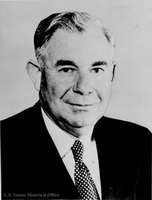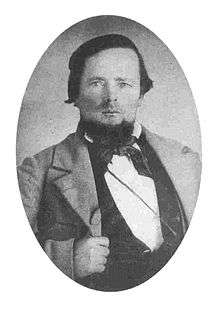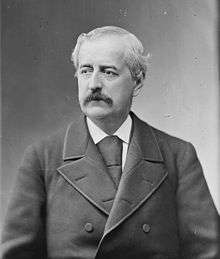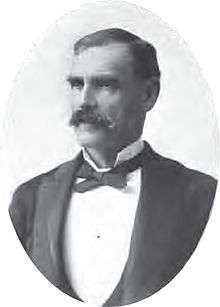List of Governors of Arizona
| Governor of Arizona | |
|---|---|
|
| |
| Style | The Honorable |
| Residence | No official residence |
| Term length | Four years, can succeed self once; eligible again after 4-year respite |
| Inaugural holder | George W. P. Hunt |
| Formation | February 14, 1912 |
| Deputy | None |
| Salary | $95,000 (2013)[1] |
| Website | www.azgovernor.gov |
The Governor of Arizona is the head of the executive branch of Arizona's state government and the commander-in-chief of the state's military forces. The governor has a duty to enforce state laws, and the power to either approve or veto bills passed by the Arizona Legislature, to convene the legislature, and to grant pardons, except in cases of treason and impeachment.[2]
Twenty-two people have served as governor over 26 distinct terms. All of the repeat governors were in the state's earliest years, when George W. P. Hunt and Thomas Edward Campbell alternated as governor for 17 years and, after a two-year gap, Hunt served another term. One governor, Evan Mecham, was successfully impeached, and one, Fife Symington III, resigned upon being convicted of a felony. The longest-serving governor was Hunt, who was elected seven times and served just under fourteen years. The longest single stint was that of Bruce Babbitt, who was elected to two four-year terms after succeeding to the office following the death of his predecessor, Wesley Bolin, serving nearly nine years total. Bolin had the shortest tenure, dying less than five months after succeeding as governor. Four governors were actually born in Arizona: Campbell, Sidney Preston Osborn, Rose Mofford, and Babbitt. Arizona has had four female governors, the most in the United States, and is also the only state where female governors have served in a consecutive order.[3] Because of a string of deaths in office, resignations, and an impeachment, Arizona has not had a governor whose term began and ended because of "normal" election circumstances since Jack Williams was in office (1967–1975).
The current Governor is Doug Ducey, who was elected on November 4, 2014.
Governors
Confederate Arizona
In Tucson between April 2 and April 5, 1860, a convention of settlers from the southern half of the New Mexico Territory drafted a constitution for a provisional Arizona Territory, three years before the United States would create such a territory. This proposed territory consisted of the part of New Mexico Territory south of 33° 40' N. On April 2,[4] they elected a governor, Lewis Owings. The provisional territory was to exist until such time as an official territory was created, but that proposal was rejected by the U.S. Congress at the time.[5]
On March 16, 1861, soon before the American Civil War broke out, a convention in Mesilla voted that the provisional territory should secede from the Union and join the Confederate States of America.[6] Lewis Owings remained as territorial governor.
The Confederacy took ownership of the territory on August 1, 1861, when forces led by Lieutenant Colonel John Baylor won decisive control of the territory, and Baylor proclaimed himself governor.[7] The territory was organized on February 14, 1862.[8] On March 20, 1862, Baylor issued an order to kill all the adult Apache and take their children into slavery.[7] When Confederate President Jefferson Davis learned of this order, he strongly disapproved and demanded an explanation. Baylor wrote a letter December 29, 1862, to justify his decision, and after this was received, Davis relieved Baylor of his post and commission, calling his letter an "avowal of an infamous crime."[9] By that time, the government of Confederate Arizona was in exile in San Antonio, Texas, as the territory had been effectively lost to Union forces in July 1862;[10] no new governor was appointed.
Governors of the Territory of Arizona
- For the period before Arizona Territory was formed, see the list of Governors of New Mexico Territory.
Arizona Territory was formed on February 24, 1863 from New Mexico Territory, remaining a territory for 49 years.[11] On January 18, 1867, the northwestern corner of the territory was transferred to the state of Nevada.[12]
Governors of the State of Arizona
The state of Arizona was admitted to the Union on February 14, 1912, the last of the contiguous states to be admitted.
The state constitution of 1912 called for the election of a governor every two years.[50] The term was increased to four years by a 1968 amendment.[51][52] The constitution originally included no term limit,[53] but an amendment passed in 1992 allows governors to succeed themselves only once;[50] before this, four governors were elected more than twice in a row. Gubernatorial terms begin on the first Monday in the January following the election.[50] Governors who have served the two term limit can run again after four years out of office.
Arizona is one of seven states which does not have a lieutenant governor; instead, in the event of a vacancy in the office of governor, the Secretary of State, if elected, succeeds to the office. If the secretary of state was appointed, rather than elected, or is otherwise ineligible to hold the office of governor, the first elected and eligible person in the line of succession assumes the office. The state constitution specifies the line of succession to be the Secretary of State, Attorney General, State Treasurer and Superintendent of Public Instruction, in that order. If the governor is out of the state or impeached, the next elected officer in the line of succession becomes acting governor until the governor returns or is cleared.[54] The line of succession has gone beyond secretary of state once, when Bruce Babbitt, as attorney general, became governor upon the death of Wesley Bolin; the secretary of state at the time, Rose Mofford, was an appointee to replace Bolin,[55] who himself had succeeded to the office due to the resignation of his predecessor, Raul Hector Castro. Mofford would later succeed Evan Mecham as governor when he was impeached.
| Governor[lower-alpha 13] | Term start | Term end | Term[lower-alpha 14] | Party | |||
|---|---|---|---|---|---|---|---|
| 1 |  |
George W. P. Hunt | February 14, 1912 | January 1, 1917 | 1 (1911) |
Democratic | |
| 2 (1914) | |||||||
| 2 |  |
Thomas Edward Campbell | January 1, 1917 | December 25, 1917 | 3 (1916) [lower-alpha 15] |
Republican | |
| 1 |  |
George W. P. Hunt | December 25, 1917 | January 1, 1919 | Democratic | ||
| 2 |  |
Thomas Edward Campbell | January 1, 1919 | January 1, 1923 | 4 (1918) |
Republican | |
| 5 (1920) | |||||||
| 1 |  |
George W. P. Hunt | January 1, 1923 | January 7, 1929 | 6 (1922) |
Democratic | |
| 7 (1924) | |||||||
| 8 (1926) | |||||||
| 3 | .jpg) |
John Calhoun Phillips | January 7, 1929 | January 5, 1931 | 9 (1928) |
Republican | |
| 1 |  |
George W. P. Hunt | January 5, 1931 | January 2, 1933 | 10 (1930) |
Democratic | |
| 4 | .jpg) |
Benjamin Baker Moeur | January 2, 1933 | January 4, 1937 | 11 (1932) |
Democratic | |
| 12 (1934) | |||||||
| 5 |  |
Rawghlie Clement Stanford | January 4, 1937 | January 2, 1939 | 13 (1936) |
Democratic | |
| 6 |  |
Robert Taylor Jones | January 2, 1939 | January 6, 1941 | 14 (1938) |
Democratic | |
| 7 |  |
Sidney Preston Osborn | January 6, 1941 | May 25, 1948 | 15 (1940) |
Democratic | |
| 16 (1942) | |||||||
| 17 (1944) | |||||||
| 18 (1946)[lower-alpha 16] | |||||||
| 8 |  |
Dan Edward Garvey | May 25, 1948 | January 1, 1951 | Democratic | ||
| 19 (1948) | |||||||
| 9 | .jpg) |
John Howard Pyle | January 1, 1951 | January 3, 1955 | 20 (1950) |
Republican | |
| 21 (1952) | |||||||
| 10 |  |
Ernest McFarland | January 3, 1955 | January 5, 1959 | 22 (1954) |
Democratic | |
| 23 (1956) | |||||||
| 11 |  |
Paul Fannin | January 5, 1959 | January 4, 1965 | 24 (1958) |
Republican | |
| 25 (1960) | |||||||
| 26 (1962) | |||||||
| 12 |  |
Samuel Pearson Goddard, Jr. | January 4, 1965 | January 2, 1967 | 27 (1964) |
Democratic | |
| 13 |  |
Jack Richard Williams | January 2, 1967 | January 6, 1975 | 28 (1966) |
Republican | |
| 29 (1968) | |||||||
| 30 (1970) [lower-alpha 17] | |||||||
| 14 |  |
Raul Hector Castro | January 6, 1975 | October 20, 1977 | 31 (1974) [lower-alpha 18] |
Democratic | |
| 15 |  |
Wesley Bolin | October 20, 1977 | March 4, 1978 | Democratic | ||
| 16 |  |
Bruce Babbitt | March 4, 1978 | January 5, 1987 | Democratic | ||
| 32 (1978) | |||||||
| 33 (1982) | |||||||
| 17 |  |
Evan Mecham | January 5, 1987 | April 4, 1988 | 34 (1986) [lower-alpha 19] |
Republican | |
| 18 |  |
Rose Mofford | April 4, 1988 | March 6, 1991 | Democratic | ||
| 19 |  |
Fife Symington | March 6, 1991 | September 5, 1997 | 35 (1990) |
Republican | |
| 36 (1994) [lower-alpha 20] | |||||||
| 20 |  |
Jane Dee Hull | September 5, 1997 | January 6, 2003 | Republican | ||
| 37 (1998) | |||||||
| 21 |  |
Janet Napolitano | January 6, 2003 | January 21, 2009 | 38 (2002) |
Democratic | |
| 39 (2006) [lower-alpha 21] | |||||||
| 22 |  |
Jan Brewer | January 21, 2009 | January 5, 2015 | Republican | ||
| 40 (2010) | |||||||
| 23 |  |
Doug Ducey | January 5, 2015 | Incumbent | 41 (2014) [lower-alpha 22] |
Republican | |
Living former governors of Arizona
There are five living former governors of Arizona, the oldest being Jane Dee Hull (served 1997–2003, born 1935). The most recent death of a former governor of Arizona was that of Rose Mofford (served 1988–1991, born 1922), who died on September 15, 2016.
| Governor | Gubernatorial term | Date of birth (and age) |
|---|---|---|
| Bruce Babbitt | 1978–1987 | June 27, 1938 |
| Fife Symington III | 1991–1997 | August 12, 1945 |
| Jane Dee Hull | 1997–2003 | August 8, 1935 |
| Janet Napolitano | 2003–2009 | November 29, 1957 |
| Jan Brewer | 2009–2015 | September 26, 1944 |
See also
Notes
- ↑ The range given is from the date the governor took the oath of office in Arizona, to the date the governor left office. Due to the distance from Washington, D.C., to Arizona, many governors were appointed and confirmed months before being able to exercise power in the territory.
- ↑ Gurley died on August 19, 1863, prior to taking office as governor.
- 1 2 Resigned to take an elected seat as delegate to the United States House of Representatives.
- ↑ It is unknown when Frémont took the oath of office; Goff states that he and his family arrived in Prescott on the afternoon of October 6, 1878.
- ↑ Resigned; Frémont spent little time in the territory; and the Secretary of the Territory asked him to resume his duties or resign, and he chose resignation.[19]
- ↑ Resigned after Grover Cleveland was elected, so that the Democrat could appoint a Democrat as governor.[21]
- ↑ Resigned due to a disagreement with the federal government on arid land policy.[25]
- ↑ Resigned to handle family business out of state.[28]
- ↑ Hughes had abolished many territorial offices, and unhappy officials successfully petitioned President Cleveland to remove him.[33]
- ↑ Resigned to serve in the Spanish–American War.[39]
- ↑ Asked by President Roosevelt to resign for opposing the Newlands Reclamation Act.[43]
- ↑ Resigned to accept appointment as assistant chief of the records and pension bureau at the United States Department of War.[46]
- ↑ Repeat governors are officially numbered only once; subsequent terms are marked with their original number italicized.
- ↑ Each term for which a governor is elected is listed here; if multiple governors served in a single term, due to resignations, deaths, and the like, then that term will be shared among those governors. If a governor was elected multiple times, then there will be multiple terms listed for that governor.
- ↑ Campbell's narrow election win was overturned by the Arizona Supreme Court on December 22, 1917, which, following a recount, awarded the office to Hunt. Campbell vacated the office three days later.[56]
- ↑ Osborn died in office; as secretary of state, Garvey became governor.
- ↑ The Constitution was amended in 1968 to increase gubernatorial terms from two to four years, taking effect with this election.
- ↑ Castro resigned to take post as United States Ambassador to Argentina. As secretary of state, Bolin became governor, but died in office before the end of the term. The secretary of state at the time of Bolin's death had been appointed,[55] not elected, and thus not in the line of succession according to the Arizona constitution.[54] Therefore, as state attorney general, Babbitt then became governor.
- ↑ Mecham was impeached and removed from office on charges of obstruction of justice and misuse of government funds.[57] As secretary of state, Mofford became governor.
- ↑ Arizona adopted runoff voting after Evan Mecham won with only 43% of the vote. The 1990 election was very close, and a runoff was held on February 26, 1991, which Symington won, and he was inaugurated on March 6, 1991.[58] He resigned after being convicted of bank fraud, since state law does not allow felons to hold office; the conviction was later overturned and he was pardoned by President Bill Clinton.[59] As secretary of state, Hull became governor. She did not take the oath of office until September 8, but she was governor for those three days regardless of the delay.[60]
- ↑ Napolitano resigned to become United States Secretary of Homeland Security. As secretary of state, Brewer became governor.
- ↑ Governor Ducey's term expires on January 7, 2019; he will not be term limited.
References
- General
- "Arizona: Past Governors Bios". National Governors Association. Retrieved September 3, 2015.
- Goff, John S. (1978). Arizona Territorial Officials Volume II: The Governors 1863–1912. Black Mountain Press. OCLC 5100411.
- McClintock, James H. (1916). Arizona, Prehistoric, Aboriginal, Pioneer, Modern: The Nation's Youngest Commonwealth Within a Land of Ancient Culture. The S.J. Clarke Publishing Co. OCLC 5398889. Retrieved October 11, 2008.
- Wagoner, Jay J. (1970). Arizona Territory 1863–1912: A Political History. University of Arizona Press. ISBN 0-8165-0176-9.
- Constitution
- "Constitution of the State of Arizona". Arizona Legislature. 1912. Retrieved September 23, 2008.
- Specific
- ↑ "CSG Releases 2013 Governor Salaries". The Council of State Governments. June 25, 2013. Retrieved November 23, 2014.
- ↑ AZ Const. art. 5
- ↑ "Janet Napolitano". National Governors Association. Retrieved September 3, 2015.
- ↑ Robinson, William Morrison (1941). Justice in Grey: A History of the Judicial System of the Confederate States of America. Harvard University Press. p. 310. Retrieved August 3, 2010.
- ↑ McClintock pp. 142–143
- ↑ Colton, Ray Charles (1985). The Civil War in the Western Territories. University of Oklahoma Press. pp. 9–10. ISBN 0-8061-1902-0. Retrieved August 3, 2010.
- 1 2 Colton, Ray Charles (1985). The Civil War in the Western Territories. University of Oklahoma Press. pp. 122–123. ISBN 0-8061-1902-0. Retrieved August 3, 2010.
- ↑ Cowles, Calvin Duvall (1900). The War of the Rebellion: A Compilation of the Official Records of the Union and Confederate Armies. United States Government Printing Office. p. 930. Retrieved August 3, 2010.
- ↑ Wellman, Paul Iselin (1987). Death in the Desert: The Fifty Years' War for the Great Southwest. University of Nebraska Press. pp. 83–85. ISBN 0-8032-9722-X. Retrieved August 3, 2010.
- ↑ Heidler, David Stephen; Jeanne t. Heidler; David J. Coles (2002). Encyclopedia Of The American Civil War: A Political, Social, and Military History. W. W. Norton & Company. p. 1412. ISBN 0-393-04758-X. Retrieved August 3, 2010.
- ↑ Wagoner p. 20
- ↑ McClintock p. 329
- ↑ McGinnis, Ralph Y.; Calvin N. Smith (1994). Abraham Lincoln and the Western Territories. Rowman & Littlefield. p. 91. ISBN 0-8304-1247-6.
- ↑ Goff pp. 26–27
- ↑ Nicolson, John (1974). The Arizona of Joseph Pratt Allyn. University of Arizona Press. p. 39. ISBN 0-8165-0386-9. Retrieved October 11, 2008.
McCormick was appointed April 10 and took the oath of office July 9, 1866.
- ↑ Goff p. 55
- ↑ Goff p. 66
- ↑ Goff pp. 76–77
- 1 2 3 Walker, Dale L. (1997). Rough Rider: Buckey O'Neill of Arizona. University of Nebraska Press. pp. 23–24. ISBN 0-8032-9796-3. Retrieved August 3, 2010.
- ↑ Goff p. 88
- 1 2 Wagoner p. 221
- ↑ Goff pp. 98–99
- ↑ Goff p. 112
- ↑ Walker, Dale L. (1997). Rough Rider: Buckey O'Neill of Arizona. University of Nebraska Press. p. 81. ISBN 0-8032-9796-3. Retrieved August 3, 2010.
- ↑ Wagoner p. 276
- ↑ Goff pp. 118–119
- ↑ "Arizona". Appletons' Annual Cyclopaedia and Register of Important Events. New. series, Volume 17 (1892 ed.). 1893. p. 16. Retrieved October 10, 2008.
- ↑ Goff p. 127
- ↑ A Biographical Congressional Directory, 1774 to 1903. United States Government Printing Office. 1903. p. 711. Retrieved October 11, 2008.
- ↑ Goff p. 129
- ↑ Goff p. 146
- ↑ Lincoln Library, Carl Sandburg Collections (University of Illinois at Urbana-Champaign Library) (1897). "Arizona". Appletons' Annual Cyclopaedia and Register of Important Events. 3rd. series, Volume 1 (1896 ed.). p. 26. Retrieved October 11, 2008.
- ↑ Johnson, Rossiter; John Howard Brown (1904). The Twentieth Century Biographical Dictionary of Notable Americans. The Biographical Society. Retrieved October 11, 2008.
- ↑ Goff pp. 154–155
- ↑ "Franklin, Benjamin Joseph". Biographical Directory of the United States Congress. Clerk of the United States House of Representatives and Historian of the United States Senate. Retrieved October 11, 2008.
- ↑ McClintock p. 345
- ↑ Goff p. 167
- ↑ Wagoner p. 345
- ↑ Roth, Mitchel P.; James Stuart Olson (2001). Historical Dictionary of Law Enforcement. Greenwood Publishing Group. p. 207. ISBN 0-313-30560-9. Retrieved October 11, 2008.
- ↑ McClintock p. 346
- ↑ Goff p. 132
- ↑ "Resignation of Arizona's Governor". The New York Times. April 30, 1902. Retrieved October 11, 2008.
- ↑ Goff p. 136
- ↑ Goff p. 178
- ↑ Herner, Charles (1970). The Arizona Rough Riders. University of Arizona Press. p. 221. ISBN 0-8165-0206-4. Retrieved October 11, 2008.
- 1 2 3 McClintock p. 354
- ↑ Goff p. 189
- ↑ McClintock p. 359
- ↑ Goff p. 199
- 1 2 3 AZ Const. art 5, § 1
- ↑ Ralph E. Hughes v. Douglas K. Martin (PDF), (Arizona Supreme Court 2002-08-20). “Nelson involved two allegedly conflicting amendments both approved by voters in the 1968 election, to Article 5 of the Arizona Constitution. ... The other amendment, proposition 104, extended the term of offices of the executive department, including the office of state auditor, from two years to four years.”
- ↑ Berman, David R. (1998). Arizona Politics & Government: The Quest for Autonomy, Democracy, and Development. University of Nebraska Press. p. 112. ISBN 0-8032-6146-2. Retrieved August 3, 2010.
- ↑ AZ Const. art. 5, old § 1
- 1 2 AZ Const. art 5, § 6
- 1 2 "Rose Mofford". National Governors Association. Retrieved September 3, 2015.
- ↑ "George Wylie Hunt". National Governors Association. Retrieved September 3, 2015.
- ↑ "Evan Mecham". National Governors Association. Retrieved September 3, 2015.
- ↑ Mullaney, Marie Marmo (1994). Biographical Directory of the Governors of the United States, 1988–1994. Greenwood Publishing Group. pp. 29–30. ISBN 0-313-28312-5. Retrieved October 11, 2008.
- ↑ "J. Fife Symington III". National Governors Association. Retrieved September 3, 2015.
- ↑ Todd S., Purdum (1997-09-04). "Arizona Governor Convicted Of Fraud and Will Step Down". The New York Times. Retrieved October 11, 2008.
External links
| Wikimedia Commons has media related to Governors of Arizona. |










.jpg)
.jpg)







